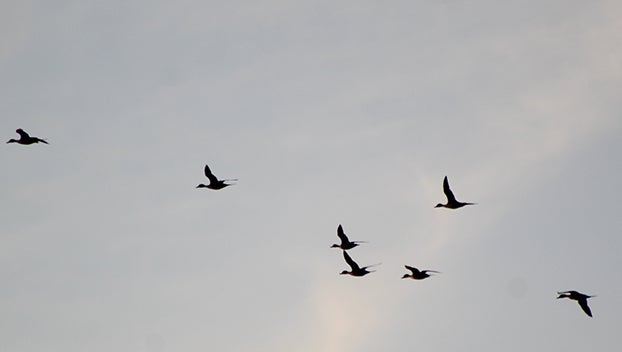Aerial Survey Report: Wetland availability below average, birds responding to waterfowl managed public land
Published 2:18 pm Wednesday, November 23, 2022

- A flock of pintail ducks fly over The Swamp area of St. Catherine Creek National Wildlife Refuge at the Sibley Unit. (Hunter Cloud | The Natchez Democrat)
|
Getting your Trinity Audio player ready...
|
The first MDWFP aerial waterfowl survey of the season occurred November 14 – 18, 2022. Similar to last November, wetland habitat availability was well below average across the Mississippi Delta. Shallow, seasonal water was not widely distributed, which is typical for this time of year in Mississippi.
However, permanent and semi-permanent wetlands like oxbow lakes and sloughs also held very low water levels. Public lands are currently providing a large proportion of intensively managed waterfowl habitat. As a result, waterfowl were observed responding to these areas, often in high numbers relative to the rest of the Delta.
Ducks were also observed using areas with large complexes of managed water across multiple private properties. As a result of the dry fall, most harvested agricultural fields have been disked, which will result in reduced food availability for waterfowl if the fields are eventually flooded.
Much opportunity remains for landowners and managers to capture rainfall with water control structures as fall and winter continue along, and as more waterfowl migrate south into the state. As in most years, flooded habitat availability was greatest in the northeast portion of the Delta.
Last week’s duck abundance estimates for the Mississippi Delta were below the November longterm averages for mallards, other dabbling ducks, diving ducks, and total ducks (Tables 1 and 2).
Dabbling ducks other than mallards comprised 53% of all duck observations. Gadwall and mallards were the two most abundant duck species observed overall, respectively. Scaup and ring-necked ducks were the most abundant diving duck species observed. The northeastern portion of the Delta contained the greatest abundances of all duck categories recorded: mallards, other dabblers, diving ducks, and total ducks overall.
During this survey, mallards and other dabbling ducks were most commonly observed using shallowly flooded agricultural fields, likely due to the below-freezing temperatures creating a need for higher carbohydrate intake for quick energy sources.
It should be noted that very few agricultural fields were flooded during this survey, but available flooded fields were highly attractive to ducks. And as usual, the greatest abundances of diving ducks were observed on aquaculture complexes.
In general, ducks were not evenly distributed across available wetland habitat. Instead, ducks were observed together in relatively large groups, which is typical of early-season behavior in areas with managed complexes of diverse wetland habitat.
Biologists expect ducks to begin to distribute further as new wetland habitats become available throughout the winter. Much of the state is forecast to receive some rainfall over the Thanksgiving holidays and weekend.
Very few concentrations of light geese (snow, blue, and Ross’) and greater whitefronted geese (commonly called specklebellies) were observed during this survey, but recent reports suggest that numbers are increasing.
The regular duck hunting season is set to open Friday, November 25, and MDWFP biologists are optimistic that state WMAs will continue to attract and hold waterfowl for an enjoyable start to the season.
Despite relatively low duck numbers overall, WMAs with water management capabilities can often have great early season hunting success. Low temperatures during and immediately following the November survey likely produced conditions strong enough to increase waterfowl migration into southern latitudes, as recent field reports would suggest.
Weekly waterfowl reports will begin the week following the duck season opener, and will include updates from Mississippi hunting reports, as well as weather and habitat conditions. For weekly waterfowl reports and more information on the MDWFP Waterfowl Program, visit our website at http://www.mdwfp.com/waterfowl.






